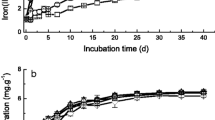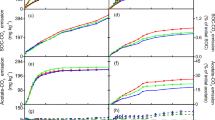Abstract
Dissimilatory iron reduction is increasingly becoming recognized as an influential process in freshwater sediments, coupling with carbon cycling. To evaluate the influence of organic matter addition on the reduction rates and dynamics of Fe(III) in wetland soils in Chagan Lake, soil slurry and microbial anaerobic incubation studies were conducted by adding a soluble and redox-active quinone (anthraquinone-2,6-disulphonate, AQDS), glucose and sodium pyruvate. In soil slurry experiment, glucose was added as a single doze and a pulsed input over time. Pulsed glucose addition promoted DIR, particularly in the later incubation stage. The addition of different forms of carbon significantly affected DIR in the inoculation experiment, and the addition of pyruvate increased DIR more than that of glucose in the wetland soil. The AQDS dramatically stimulated the potential DIR by 480-fold. A negative relationship was observed between pH and DIR. Besides, potential methane production was inhibited by the addition of ferrihydrite. These findings provide insight into the connection between iron and carbon input and emission.





Similar content being viewed by others
References
An ZS, Cao JJ, Anderson KK, Kawahata H, Arimoto R (2006) Biogeochemical records of past global iron connections. Climate of the Past Discussions, European Geosciences Union 2(3):233–265
Bai Y, Mellage A, Cirpka OA, Sun T, Angenent LT, Haderlein SB, Kappler A (2020) AQDS and redox-active NOM enables microbial Fe (III)-mineral reduction at cm-scales. Environ Sci Technol 54(7):4131–4139
Cai C, Leu AO, Xie GJ, Guo J, Feng Y, Zhao JX, Tyson GW, Yuan Z, Hu S (2018) Methanotrophic archaeon couples anaerobic oxidation of methane to Fe (III) reduction. ISME J 12(8):1929–1939
Cervantes FJ, Van Der Velde S, Lettinga G, Field JA (2000) Quinones as terminal electron acceptors for anaerobic microbial oxidation of phenolic compounds. Biodegradation 11:313–321
Chacon N, Silver WL, Dubinsky EA, Cusack DF (2006) Iron reduction and soil phosphorus solubilization in humid tropical forests soils: the roles of labile carbon pools and an electron shuttle compound. Biogeochemistry 78(1):67–84
Chidthaisong A, Conrad R (2000) Turnover of glucose and acetate coupled to reduction of nitrate, ferric iron and sulfate and to methanogenesis in anoxic rice field soil. FEMS Microbiol Ecol 31:73–86
Dubinsky EA, Silver WL, Firestone MK (2010) Tropical forest soil microbial communities couple iron and carbon biogeochemistry. Ecology 91:2604–2612
Emsens WJ, Aggenbach CJ, Schoutens K, Smolders AJ, Zak D, van Diggelen R (2016) Soil iron content as a predictor of carbon and nutrient mobilization in rewetted fens. PloS one 11(4):0153166
Guo M, Zhuang Q, Tan Z, Shurpali N, Juutinen S, Kortelainen P, Martikainen PJ (2020) Rising methane emissions from boreal lakes due to increasing ice-free days. Environ Res Lett 15(6):064008
He J, Qu D (2008) Dissimilatory Fe (III) reduction characteristics of paddy soil extract cultures treated with glucose or fatty acids. J Environ Sci 20(9):1103–1108
Jia R, Li L, Qu D, Mi N (2018) Enhanced iron (III) reduction following amendment of paddy soils with biochar and glucose modified biochar. Environ Sci Pollut R 25:91–103
Jiang M (2007) Transfer and transformation of iron and its environmental indication of wetland soil under different hydrogeomorphology conditions in the Sanjiang Plain. PhD thesis, Chinese Academy of Science, Changchun, China.
Jones ME, LaCroix RE, Zeigler J, Ying SC, Nico PS, Keiluweit M (2020) Enzymes, manganese, or iron? drivers of oxidative organic matter decomposition in soils. Environ Sci Technol 54(21):14114–14123
Kaiser K, Guggenberger G, Haumaier L, Zech W (1997) Dissolved organic matter sorption on sub soils and minerals studied by 13C-NMR and DRIFT spectroscopy. Eur J Soil Sci 48:301–310
Kappler A, Benz M, Schink B, Brune A (2004) Electron shuttling via humic acids in microbial iron (III) reduction in a freshwater sediment. FEMS Microbiol Ecol 47:85–92
Keller JK, Weisenhorn PB, Megonigal JP (2009) Humic acids as electron acceptors in wetland decomposition. Soil Biol Biochem 41:1518–1522
Lipson DA, Jha M, Raab TK, Oechel WC (2010) Reduction of iron (III) and humic substances plays a major role in anaerobic respiration in an Arctic peat soil. Biogeosciences. https://doi.org/10.1029/2009JG001147
Lipson DA, Raab TK, Goria D, Zlamal J (2013) The contribution of Fe (III) and humic acid reduction to ecosystem respiration in drained thaw lake basins of the Arctic Coastal Plain. Global Biogeochem Cycles 27:399–409
Lovley DR (1991) Dissimilatory Fe (III) and Mn (IV) reduction. FEMS Microbiol Rev 55:259–287
Lovley DR, Coates JD (2000) Novel forms of anaerobic respiration of environmental relevance. Curr Opin Microbiol 3:252–256
Lovley DR, Coates JD, Blunt-Harris EL, Phillips EJ, Woodward JC (1996) Humic substances as electron acceptors for microbial respiration. Nature 382:445
Lovley DR, Phillips EJ (1986) Organic matter mineralization with reduction of ferric iron in anaerobic sediments. Appl Environ Microbiol 51:683–689
Mitsch WJ, Gosselink JG (2015) Wetlands, 5th edn. Hoboken, New Jersey
Myers CR, Nealson KH (1988) Bacterial manganese reduction and growth with manganese oxide as the sole electron acceptor. Science 240:1319–1321
Nealson KH, Saffarini D (1994) Iron and manganese in anaerobic respiration: environmental significance, physiology, and regulation. Annu Rev Microbiol 48:311–343
Pan W, Kan J, Inamdar S, Chen C, Sparks D (2016) Dissimilatory microbial iron reduction release DOC (dissolved organic carbon) from carbon-ferrihydrite association. Soil Biol Biochem 103:232–240
Peretyazhko T, Sposito G (2005) Iron (III) reduction and phosphorous solubilization in humid tropical forest soils. Geochim Cosmochim Ac 69:3643–3652
Poulton SW, Canfield DE (2005) Development of a sequential extraction procedure for iron: implications for iron partitioning in continentally derived particulates. Chem Geol 214:209–221
Qu D, Ratering S, Schnell S (2004) Microbial reduction of weakly crystalline iron (III) oxides and suppression of methanogenesis in paddy soil. Bull Environ Contam Toxicol 72:1172–1181
Roden E, Wetzel RG (2002) Kinetics of microbial Fe (III) oxide reduction in freshwater wetland sediments. Limnol Oceanogr 47(1):198–211
Roden EE, Wetzel RG (2003) Competition between Fe (III)-reducing and methanogenic bacteria for acetate in iron-rich freshwater sediments. Microb Ecol 45(3):252–258
Schilling K, Borch T, Rhoades CC, Pallud CE (2019) Temperature sensitivity of microbial Fe (III) reduction kinetics in subalpine wetland soils. Biogeochemistry 142:19–35
Sigren LK, Lewis ST, Fisher FM, Sass RL (1997) Effects of field drainage on soil parameters related to methane production and emission from rice paddies. Global Biogeochem Cycles 11:151–162
Song K, Wang Z, Blackwell J, Zhang B, Li F, Zhang Y, Jiang G (2011) Water quality monitoring using Landsat Themate Mapper data with empirical algorithms in Chagan Lake. China J Appl Remote Sens 5(1):053506
van Bodegom PM, Scholten JCM, Stams AJM (2004) Direct inhibition of methanogenesis by ferric iron. FEMS Microbiol Ecol 49:261–268
Weber KA, Achenbach LA, Coates JD (2006) Microorganisms pumping iron: anaerobic microbial iron oxidation and reduction. Nat Rev Microbiol 4:752
Yuan J, Ding W, Liu D, Xiang J, Lin Y (2014) Methane production potential and methanogenic archaea community dynamics along the Spartina alterniflora invasion chronosequence in a coastal salt marsh. Appl Microbiol Biotechnol 98:1817–1829
Zachara JM, Kukkadapu RK, Fredrickson JK, Gorby YA, Smith SC (2002) Biomineralization of poorly crystalline Fe (III) oxides by dissimilatory metal reducing bacteria (DMRB). Geomicrobiol J 19(2):179–207
Zhang L, Hipsey MR, Zhang GX, Busch B, Li HY (2017) Simulation of multiple water source ecological replenishment for Chagan Lake based on coupled hydrodynamic and water quality models. Water Sci Tech-W Sup 17(6):1774–1784
Zhao Q, Adhikari D, Huang R, Patel A, Wang X, Tang Y, Obrist D, Roden EE, Yang Y (2017) Coupled dynamics of iron and iron-bound organic carbon in forest soils during anaerobic reduction. Chem Geol 464:118–126
Zhou S, Xu J, Yang G, Zhuang L (2014) Methanogenesis affected by the co-occurrence of iron (III) oxides and humic substances. FEMS Microbiol Ecol 88(1):107–120
Zhu X, Yuan Y, Jiang M (2018) Effects of carbon addition on dissimilatory Fe (III) reduction in freshwater marsh and meadow wetlands. Sustainability 10:4309
Acknowledgements
This research was financially supported by the National Natural Science Foundation of China (No. 41601101, 41771106); China Postdoctoral Science Foundation (No. 20150010), International Postdoctoral Exchange Fellowship Program (No. 20160065), Tianjin Natural Science Foundation (18JCYBJC23000) and Fundamental Research of Central Public Welfare Research Institutions (2018-szjj-wll). We give great thanks to Xuehui Dong and Mingyu Sang for their help in the chemical analyses.
Author information
Authors and Affiliations
Contributions
Conceptualization: Xiaoyan Zhu, Yuxiang Yuan; Methodology: Xiaoyan Zhu, Yuxiang Yuan; Chunqing Wang; Investigation: Xindong Wei; Yuxiang Yuan; Lili Wang; Writing: Xiaoyan Zhu, Yuxiang Yuan; Chunqing Wang; Data curation: Xiaoyan Zhu, Yuxiang Yuan; Funding acquisition: Xiaoyan Zhu, Lili Wang, Chunqing Wang.
Corresponding author
Ethics declarations
Conflict of interest
It is already declared by all the authors no competing interests.
Additional information
Publisher's Note
Springer Nature remains neutral with regard to jurisdictional claims in published maps and institutional affiliations.
Rights and permissions
About this article
Cite this article
Zhu, X., Yuan, Y., Wei, X. et al. Dissimilatory iron reduction and potential methane production in Chagan Lake wetland soils with carbon addition. Wetlands Ecol Manage 29, 369–379 (2021). https://doi.org/10.1007/s11273-021-09783-y
Received:
Accepted:
Published:
Issue Date:
DOI: https://doi.org/10.1007/s11273-021-09783-y




